Southport Corporation Tramways
History
Southport Corporation became a tramway owner in 1896 when it bought the tracks of the Southport Tramways Company (a standard gauge horse tramway) within the borough; although the corporation wished to control tramway development in the town, it did not want to run the trams itself at this date, so operation was leased back to the STCo.
Nothing further happened until 1899, when the British Electric Traction Company Ltd acquired a controlling interest in both of Southport's horse tramways, the STCo and the Birkdale and Southport Tramways Company. At this time, the BETCo was aggressively purchasing horse and steam-operated tramways across the British Isles, with the intention of converting them to electric traction. Although the corporation was initially favourable to the BETCo's plans (effectively a single electric tramway system in Southport and neighbouring Birkdale), it subsequently decided to build and operate its own municipal system. Matters progressed quickly, with reconstruction (including the building of new lines) commencing on the 15th January 1900, and the first corporation electric tramcar running on the 15th July of that year.
The corporation then reached agreement with the B&STCo to purchase the company's tracks within the borough, which it did on the 1st January 1901, leasing them back to the company until the end of the year. The corporation also reached an agreement with the STCo, which required the company to convert their former lines in Southport to electric traction, in return for a 21-year operating lease (from 15th July 1901). The reason for this lease arrangement, as opposed to Southport working the lines itself, was because the STCo's main line ran across the borough boundary and into neighbouring Birkdale.
The corporation subsequently took over the working of the former B&STCo's horse services on the 15th December 1901, which it operated for just three days shy of a year, the last horse tram of all running on the 12th December 1902.
Southport became a County Borough on the 1st April 1912, absorbing Birkdale Urban District Council in the process, and thereby becoming the owner of all the tracks leased to the STCo by Birkdale UDC. Following negotiation with the STCo, the corporation acquired the company on the 1st March 1918, finally creating a single, unified tramway serving Southport and Birkdale.
At the end of the Great War, the tramway, like most others across the country, was badly run down, however, unlike many concerns, Southport had already made the decision to invest in its system, renewing tracks and replacing worn-out tramcars.
The corporation bought its first bus in 1924, and gradually expanded its fleet, taking the decision in 1930 to formally abandon the tramway system in favour of buses. The first route closures occurred on the 31st of March 1931, with the last tram of all running on the 31st December 1934.
The municipal transport undertaking was re-named 'Southport Corporation Transport' in 1934, in order to reflect the change to motorbus-only operation.
At its maximum, the SCT operated 17.3 miles of tramway, with lines running: northeastwards to High Park and Churchtown; southeastwards to Blowick and Kew Gardens; southwards to Bedford Park and the Crown Hotel in Birkdale; and southwestwards to Smedley Hydro Hotel (also in Birkdale).
Uniforms
Although the corporation operated horse trams for almost one year (from December 1901 to December 1902), photographs which unequivocally date from this period have yet to come to light, so it is currently impossible to state whether the corporation issued horsecar staff with uniforms or simply continued with the 'informal attire' policy of the B&STCo (see link).
The precise chronology of the uniforms issued following electrification is currently unclear, though it is likely that the initial issues were double-breasted, with four pairs of buttons (see link) — the top set initially worn between the lapels and collars, but later on moved to a more conventional position — and with three pockets at waist level. The lapels carried a badge on the bearer's right-hand side, probably an employee number, though during the Great War, these seem to have fallen out of use, leaving the jackets totally devoid of insignia. Caps were in a kepi style with a stiff glossy peak, and carried a large brass cap badge comprising the municipal shield and motto, all within a wreath, below which was a ribbon containing the words 'CORPN TRAMWAYS' (see below). The kepi style caps were replaced with more a modern soft-topped style of cap some time around the beginning of the Great War, or possibly shortly before, but initially only for motormen; conductors eventually following suit, but seemingly not until after the war.
Motormen and conductors were also issued with double-breasted greatcoats with five pairs buttons, three pockets and high, fold-over collars that were occasionally worn open; the collars carried an employee number pre-fixed with a grade initial, 'C' for conductor and 'M' for motorman. These were almost certainly in brass to match the buttons.
Photographs of inspectors have yet to surface, so it is currently impossible to say what uniforms they wore.
Southport, in common with many UK tram operators, employed women during the Great War to replace male staff lost to the armed services. These ladies — seemingly referred to as either 'Lady Guards' or 'Conductorettes' in Southport — were issued with single-breasted jackets with a five pairs of buttons, four pockets, lapels and epaulettes (with button closures); the lapels carried an employee number, whilst the epaulettes appear to have been left plain. A long matching skirt was also issued. Headgear comprised a baggy cap with a glossy peak; this bore the same municipal cap badge as male employees' caps.
Further reading
For a history of Southport's tramways, see: 'Southport in the Age of the Tram' by John Dean and Cedric Greenwood; Sliver Link Publishing (2008).
Images
Motormen and conductors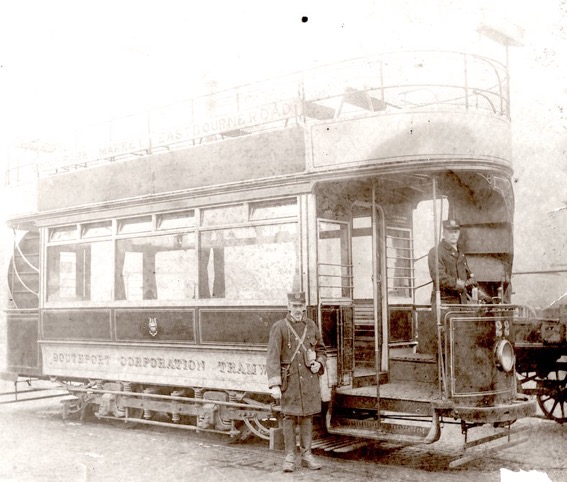
Tramcar No 22 and crew — photo undated, but judging by the excellent condition of the tramcar, probably taken shortly after its delivery in 1902. This vehicle had been top covered by 1910, so the date can be no later than this. Author's Collection.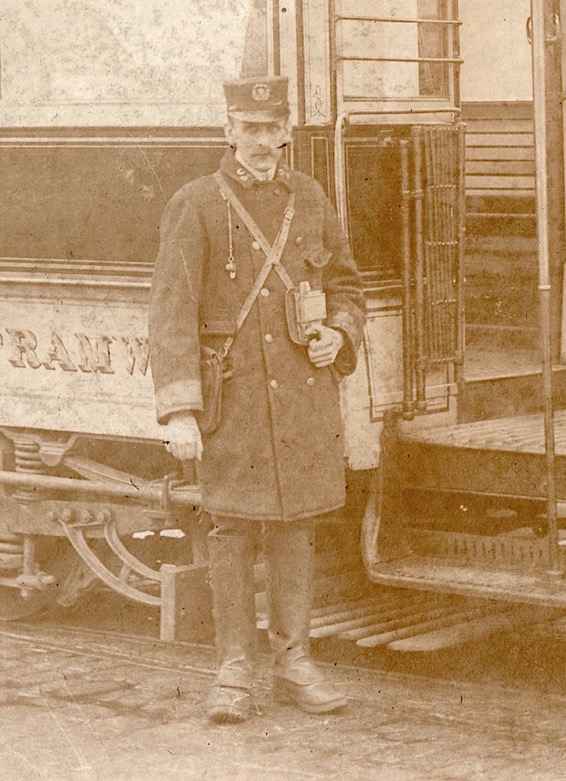
A blow-up of the above photo showing the conductor in his clogs and gaiters. His greatcoat carries his employee number on both collars (possibly '50'), prefixed with a 'C', denoting that he was a conductor; this is in contrast to the motorman, whose collars are plain. The cap is a kepi, carrying an elaborate 'Corporation Tramways' cap badge (see below).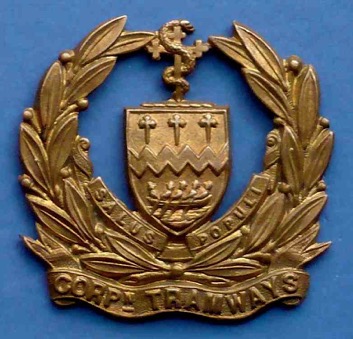
Southport Corporation Tramways cap badge — brass. Author's Collection.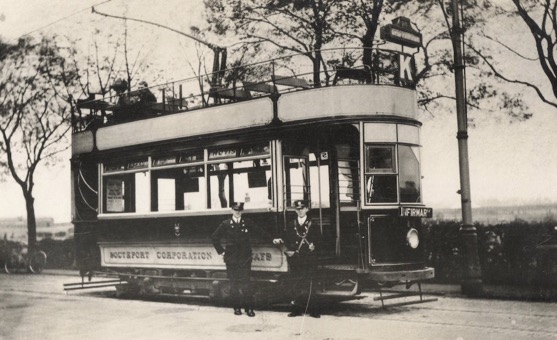
The crew of Tramcar No 14 stand with their charge at the Kew Gardens terminus around 1912, prior to reversing the trolley pole for the inward journey. Photo by W A Camwell; Author's Collection.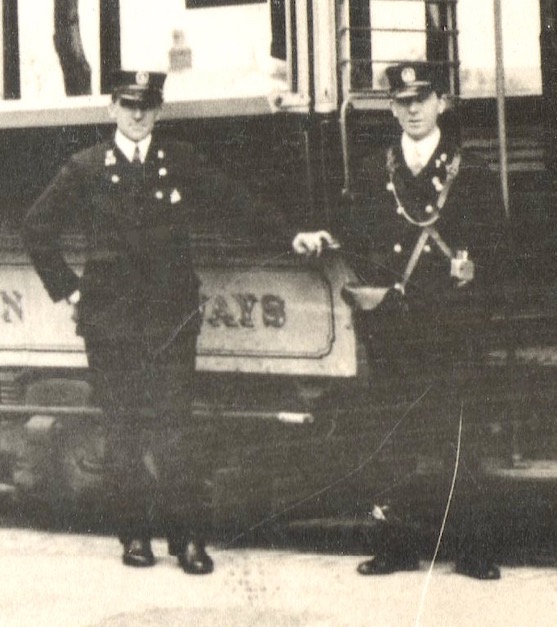
A blow-up of the above photo showing the motorman and conductor, both of them in kepi-style caps, which were by this time, somewhat old fashioned. Photo courtesy of the Tramways and Light Railway Society.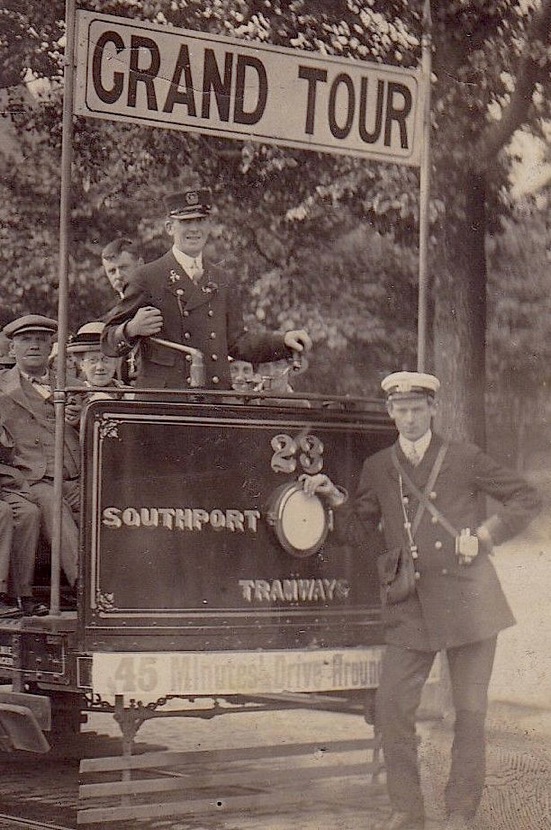
The crew of what would appear to be a brand-new No 23 (a 'toastrack') pose for the cameraman on a 'Grand Tour' service. The service was inaugurated in 1914 using Tramcar No 21, and this car, No 23, was delivered the following year, so the photo was probably taken in that year, though it is difficult to say with certainty as Southport seems to have kept these vehicles in immaculate condition. The motorman is wearing a kepi-style cap, in contrast to the conductor, who has a soft-topped cap with a white rain cover. The motorman's lapel badge seems to be 'C74', which suggests that he may only recently have passed out as a motorman, having previously served as a conductor. Author's Collection.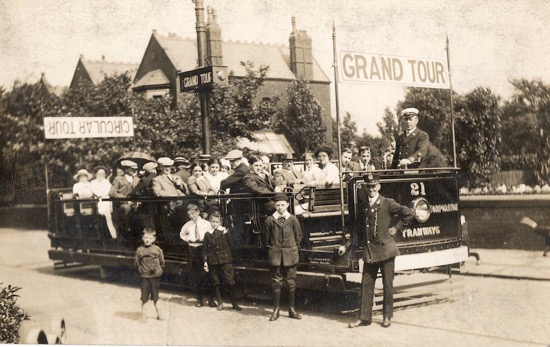
Another toastrack shot, this time of No 21, again seemingly in pristine condition, but from the plethora of large flat caps, possibly taken after the Great War rather than during it. Author's Collection.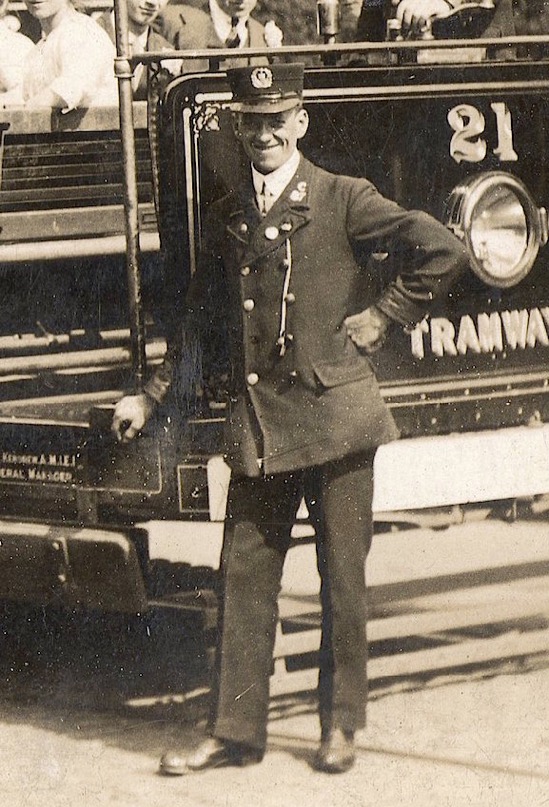
A blow-up of the above photo showing the conductor in his smart uniform and kepi-style cap with prominent cap badge. He appears to be Employee 'C87', the 'C' prefix correctly denoting him as a conductor.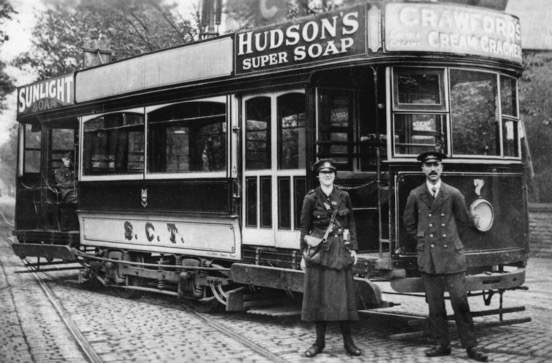
A conductress and motorman with 'California-type' Tramcar No 7 — photo undated, but almost certainly taken during the Great War. Author's Collection.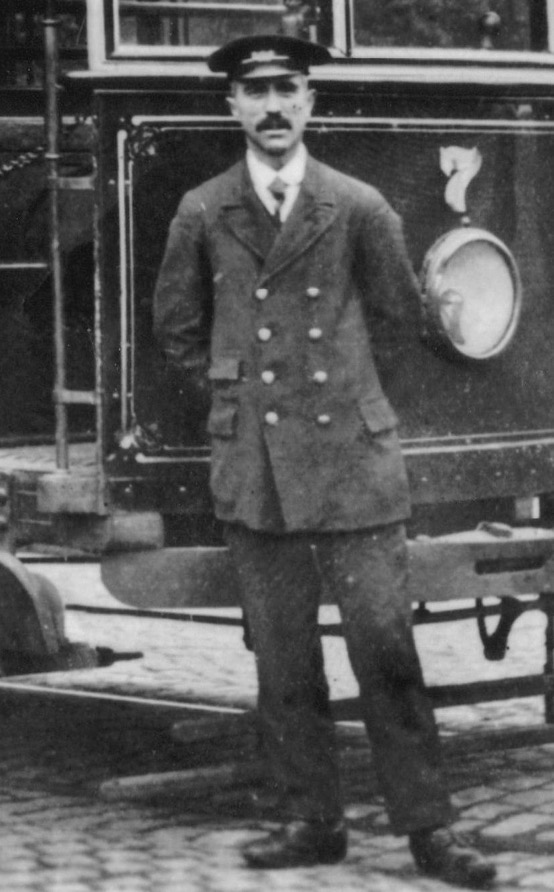
A blow-up of the above photo showing the motorman. By this time staff were clearly wearing rather squat military-style caps, the top of which, in this photo, obscures the bearer's cap badge. The lapels and collars are plain, i.e., devoid of badges.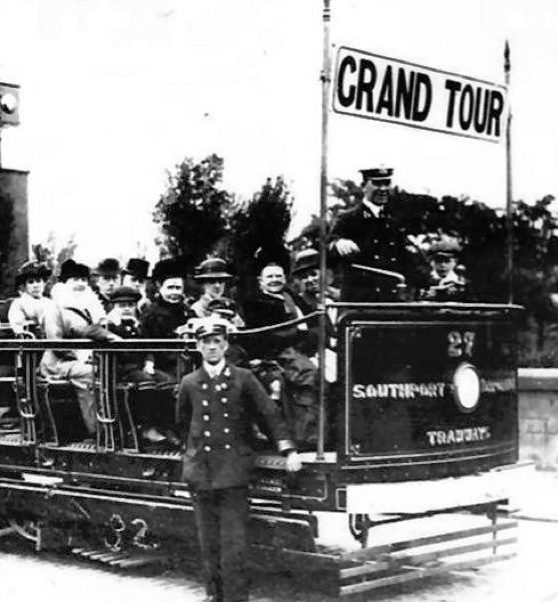
A conductor and motorman, in military-style caps, with another immaculately turned-out toastrack, Tramcar No 27 — photo undated, but probably taken after the Great War. Photo courtesy of Duncan Holden.
Female staff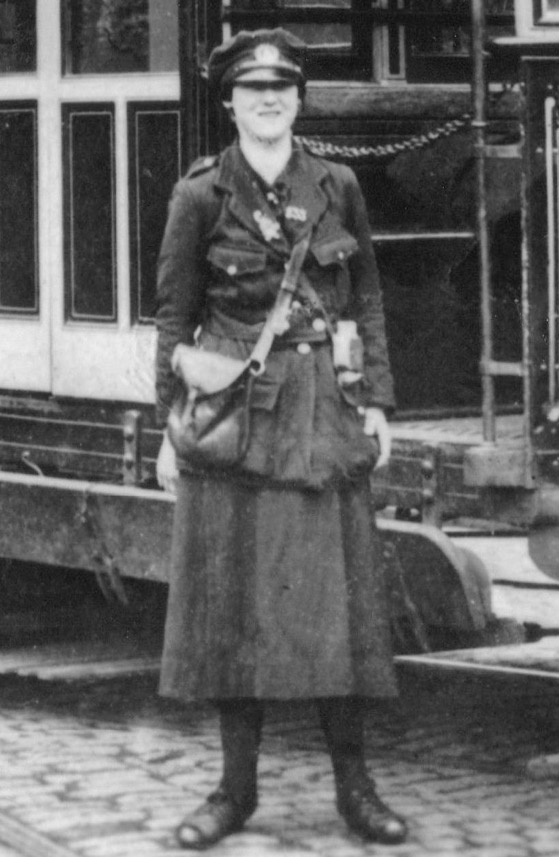
A blow up of the Great War photograph of No 7 above, showing the conductress, who would appear to be Employee No C33.